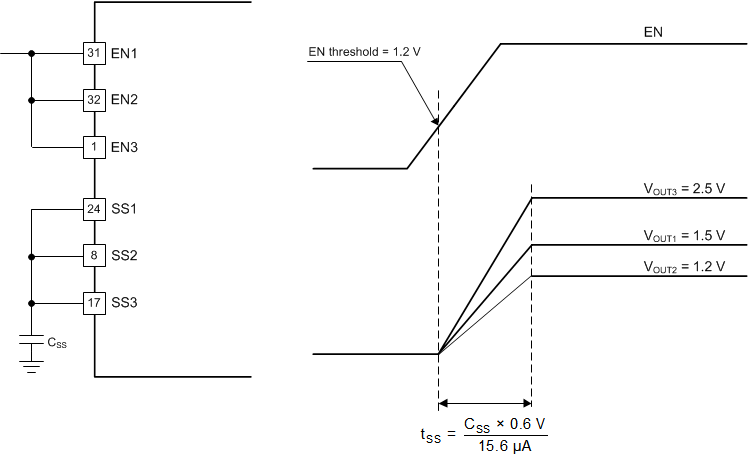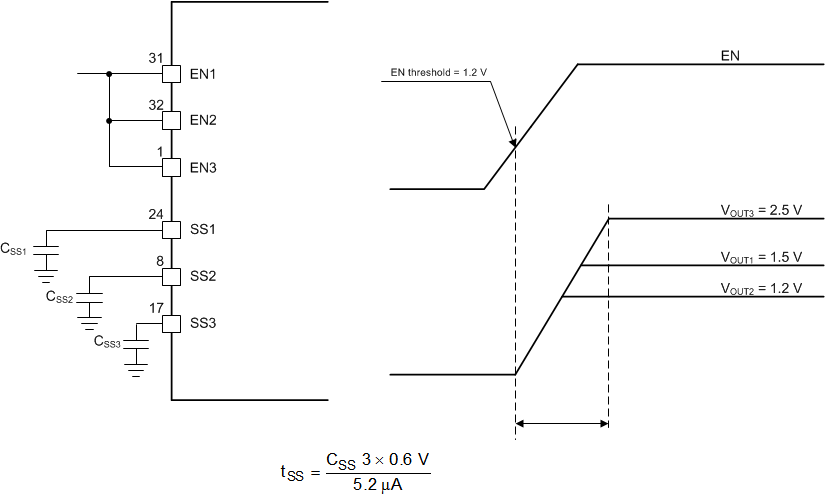SLVSE48C january 2018 – may 2023 TPS65268-Q1
PRODUCTION DATA
- 1
- 1 Features
- 2 Applications
- 3 Description
- 4 Revision History
- 5 Pin Configuration and Functions
- 6 Specifications
-
7 Detailed Description
- 7.1 Overview
- 7.2 Functional Block Diagram
- 7.3
Feature Description
- 7.3.1 Adjusting the Output Voltage
- 7.3.2 Enable and Adjusting UVLO
- 7.3.3 Soft-Start Time
- 7.3.4 Power-Up Sequencing
- 7.3.5 V7V Low-Dropout Regulator and Bootstrap
- 7.3.6 Out-of-Phase Operation
- 7.3.7 Output Overvoltage Protection (OVP)
- 7.3.8 Slope Compensation
- 7.3.9 Overcurrent Protection
- 7.3.10 Power Good
- 7.3.11 Thermal Shutdown
- 7.4 Device Functional Modes
- 8 Application and Implementation
- 9 Device and Documentation Support
- 10Mechanical, Packaging, and Orderable Information
Package Options
Mechanical Data (Package|Pins)
- RHB|32
Thermal pad, mechanical data (Package|Pins)
- RHB|32
Orderable Information
7.3.3 Soft-Start Time
The voltage on the respective SSx pin controls the startup of buck output. When the voltage on the SSx pin is less than the internal 0.6-V reference, the TPS65268-Q1 device regulates the internal feedback voltage to the voltage on the SSx pin instead of 0.6 V. The SSx pin can be used to program an external soft-start function or to allow the output of buck converter to track another supply during start-up. The device has an internal pullup current source of 5.2 µA (typical) that charges an external soft-start capacitor to provide a linear ramping voltage at the SSx pin. The TPS65268-Q1 device regulates the internal feedback voltage to the voltage on the SSx pin, allowing the output voltage to rise smoothly from 0 V to the regulated voltage of the pin without inrush current. Use Equation 4 to calculate the approximate soft-start time.

where
- tSS is the soft-start time
- CSS is the soft-start capacitance
- ISS is the soft-start current
- Vref is the reference voltage
Many of the common power-supply sequencing methods can be implemented using the SSx and ENx pins. Figure 7-5 shows the method implementing ratiometric sequencing by connecting the SSx pins of the three buck channels. The regulator outputs ramp up and reach regulation at the same time. When calculating the soft-start time, the pullup current source must be tripled in Equation 4.
 Figure 7-5 Ratiometric Power-Up Using SSx Pins
Figure 7-5 Ratiometric Power-Up Using SSx PinsThe user can implement simultaneous power-supply sequencing by connecting the capacitor to the SSx pin, shown in Figure 7-6. Use Equation 4 and Equation 5 to calculate the value of the capacitors.

 Figure 7-6 Simultaneous Startup Sequence Using SSx Pins
Figure 7-6 Simultaneous Startup Sequence Using SSx Pins